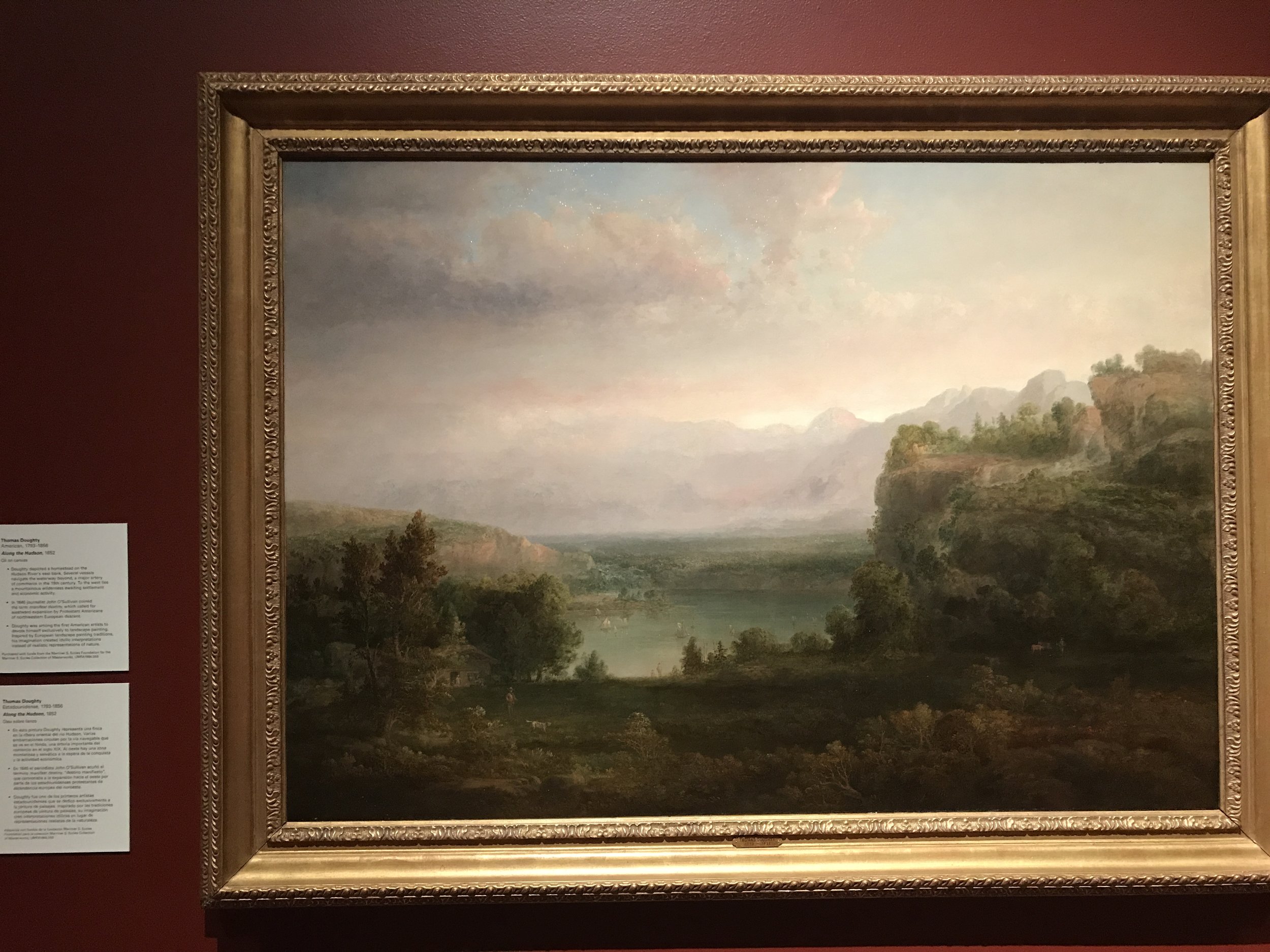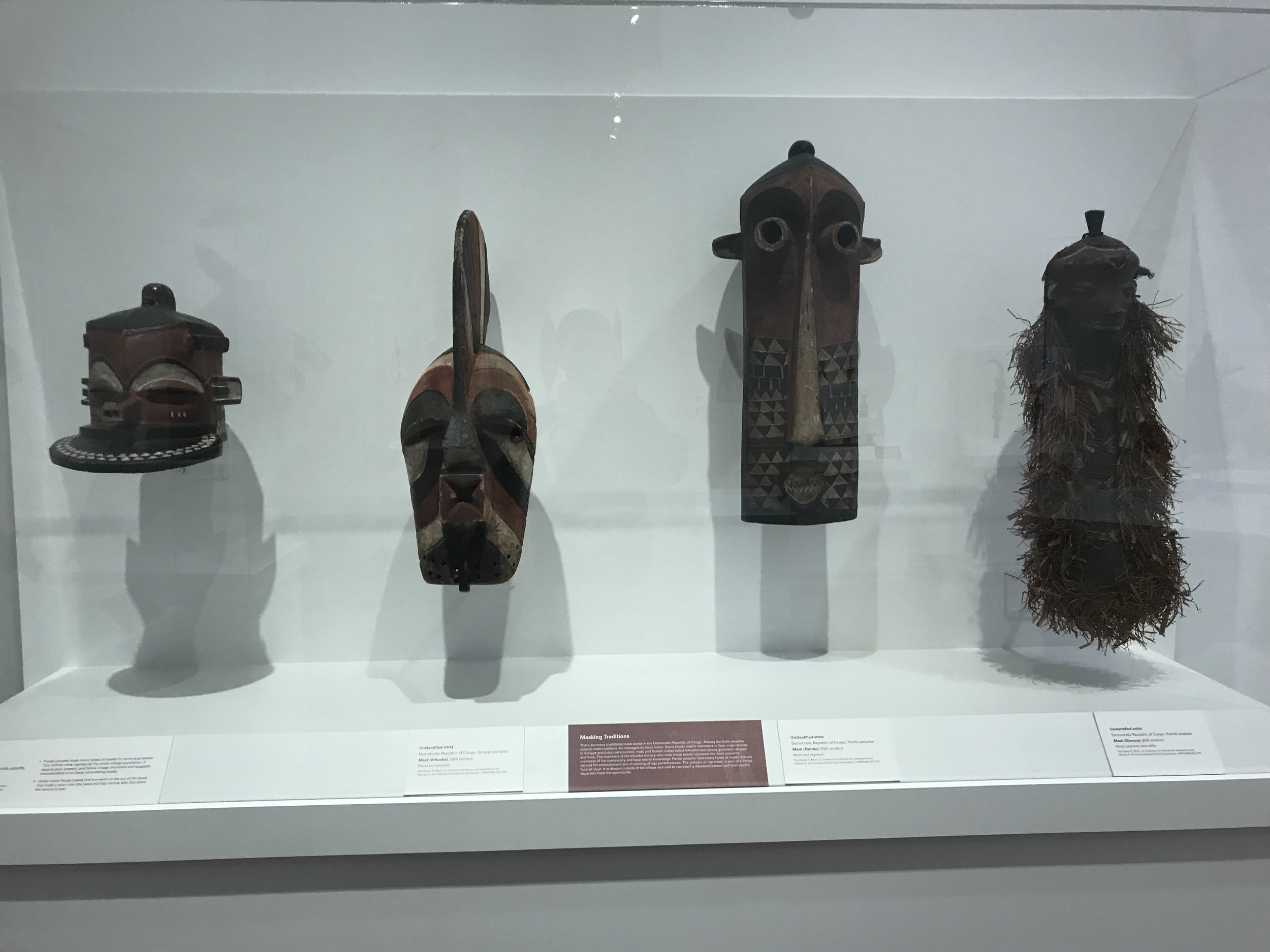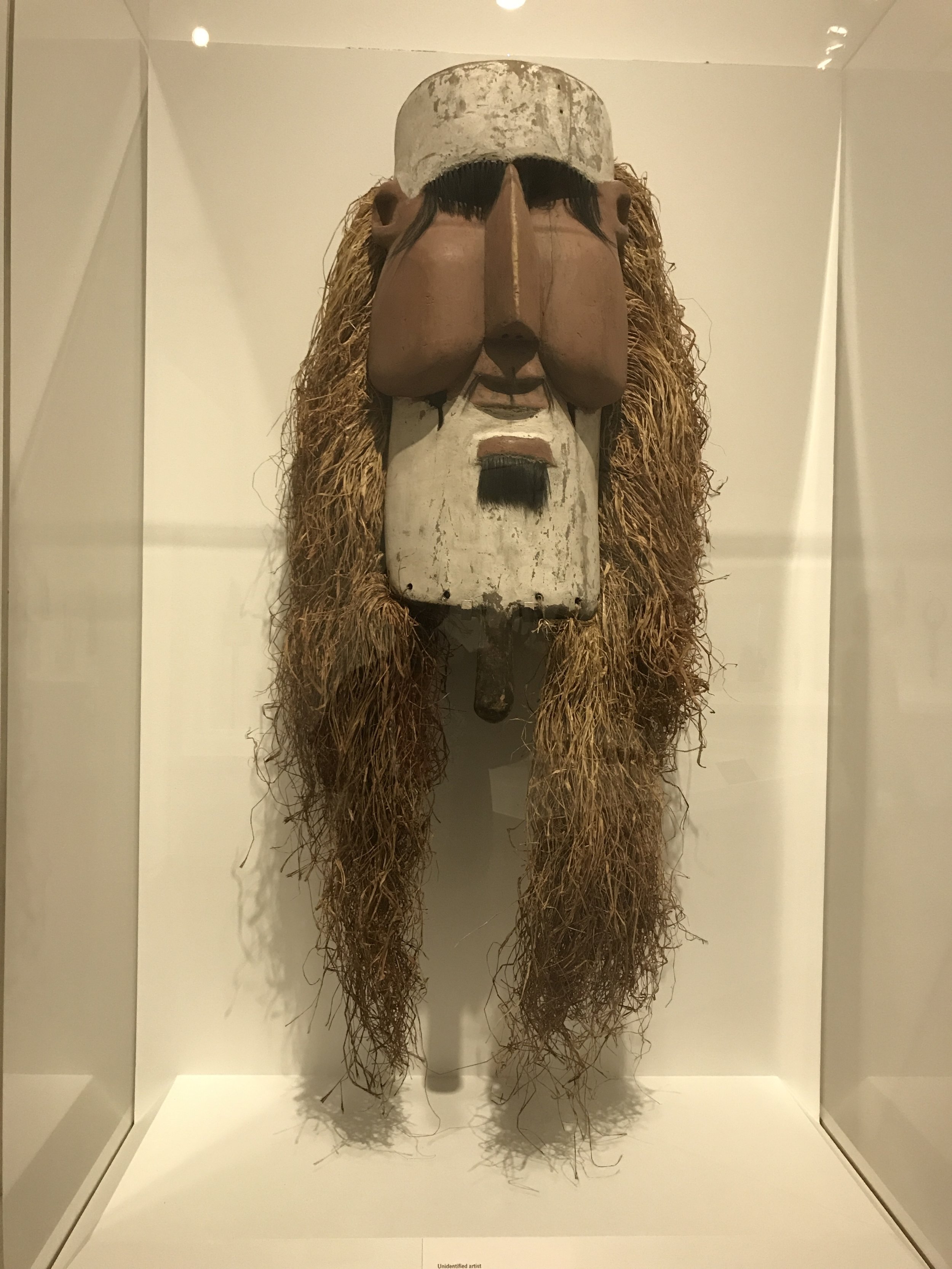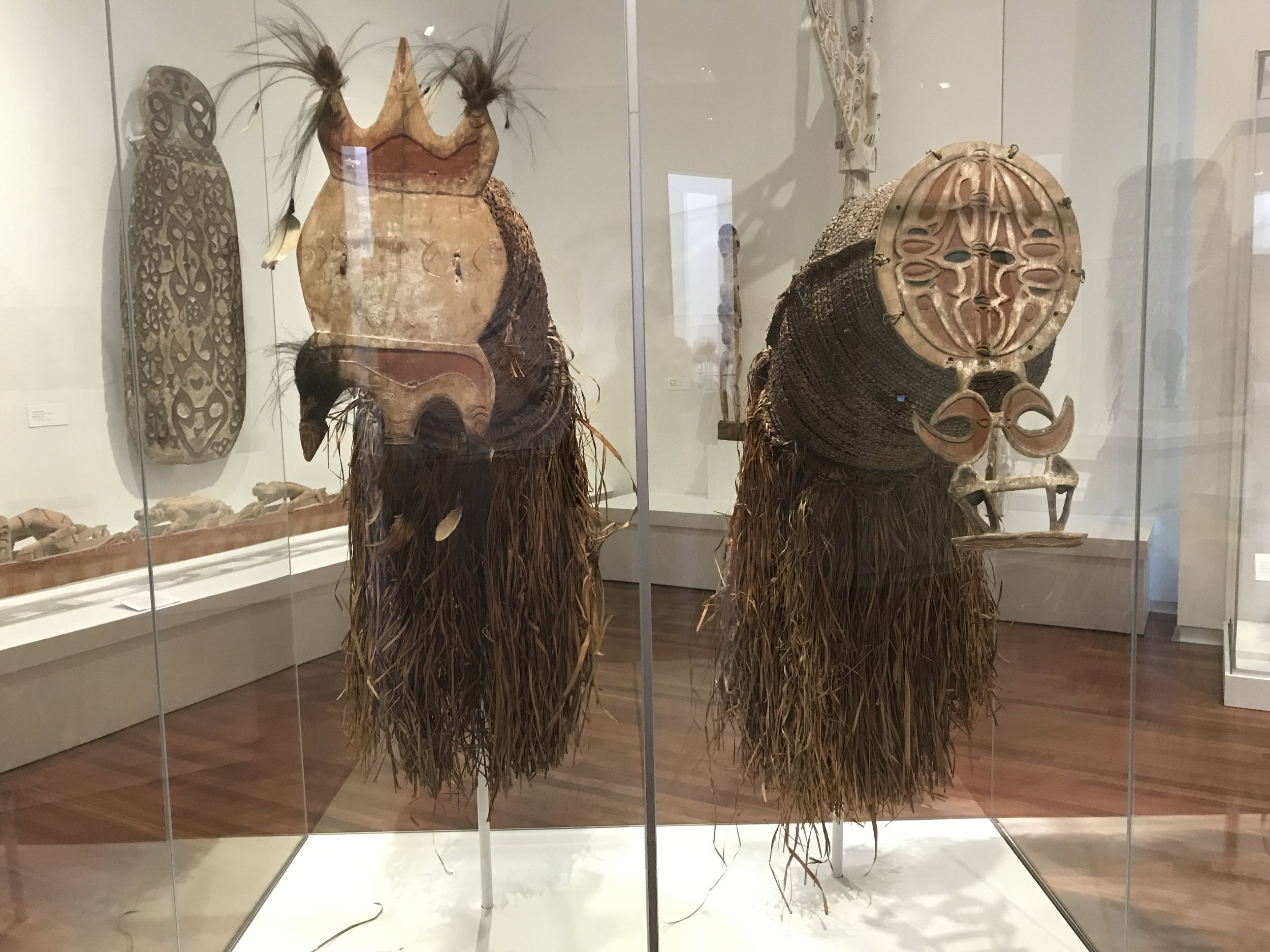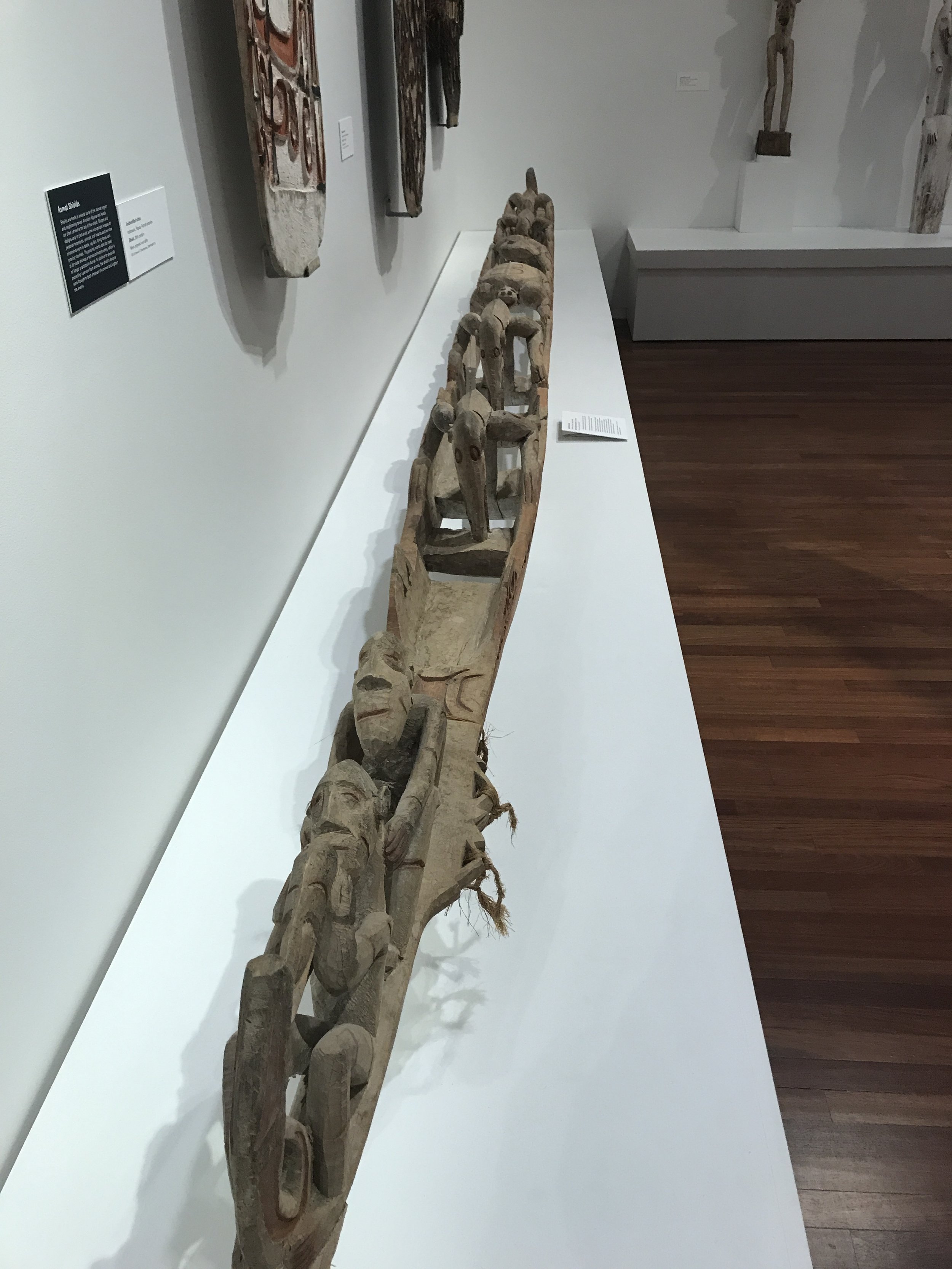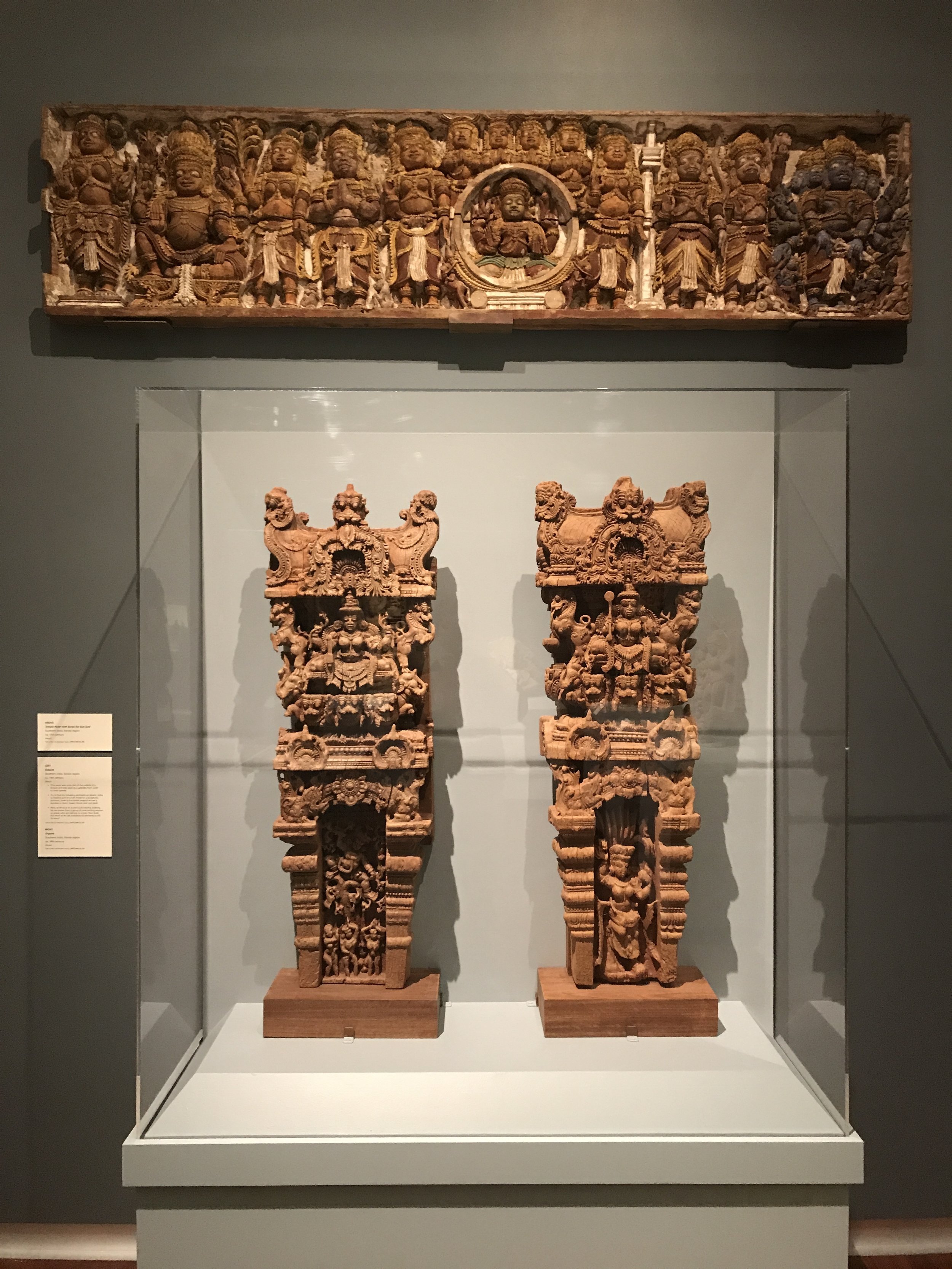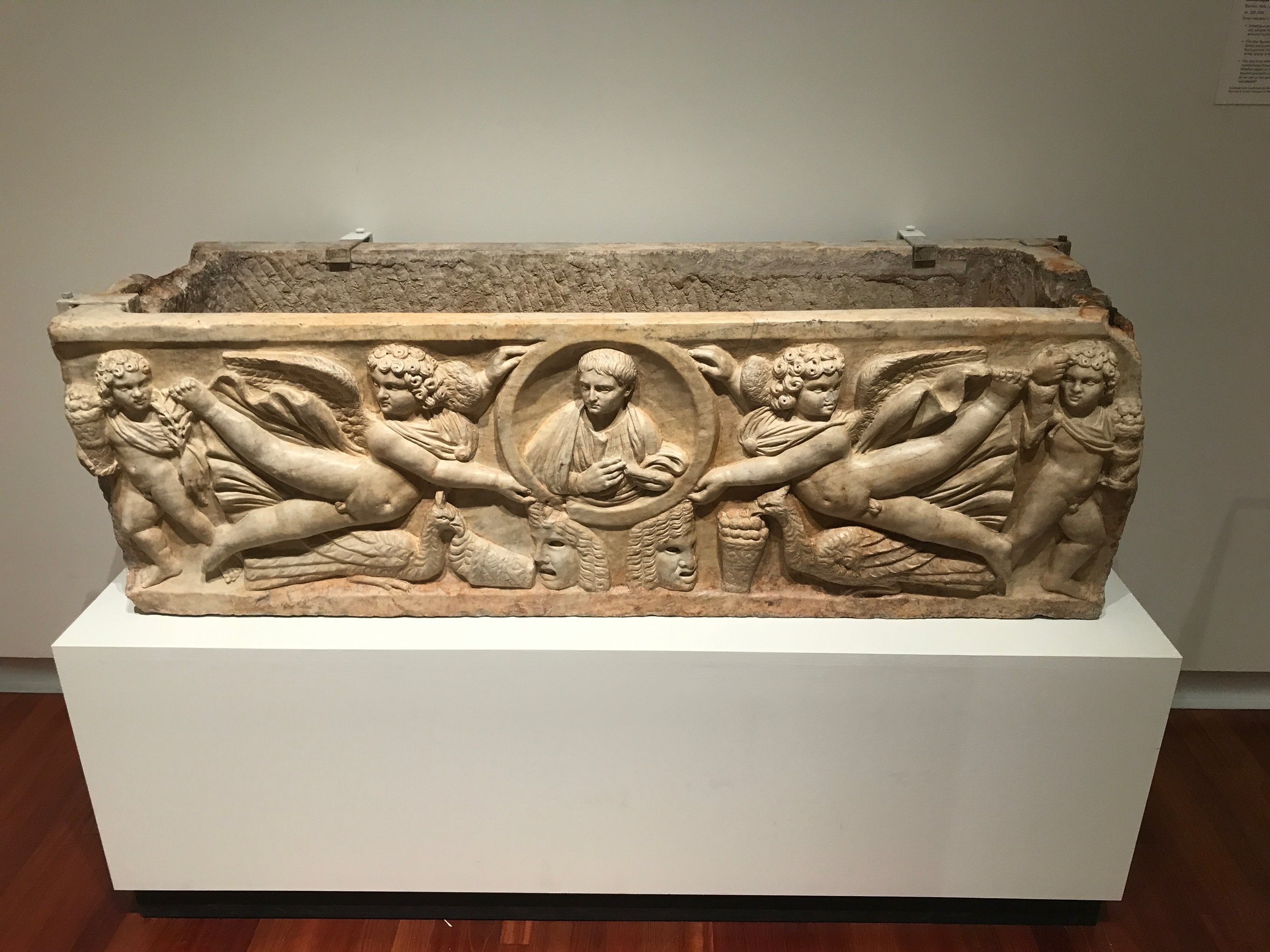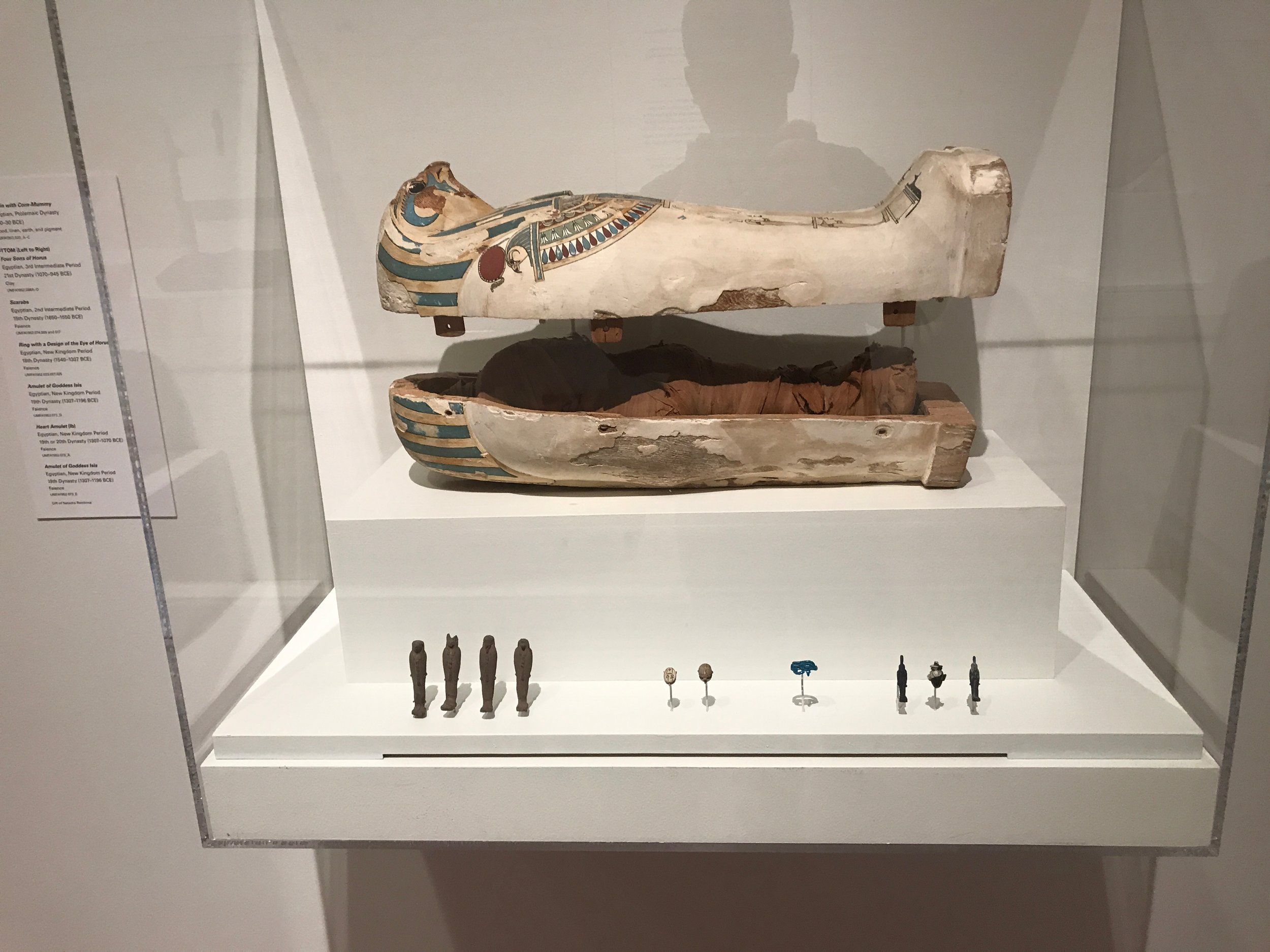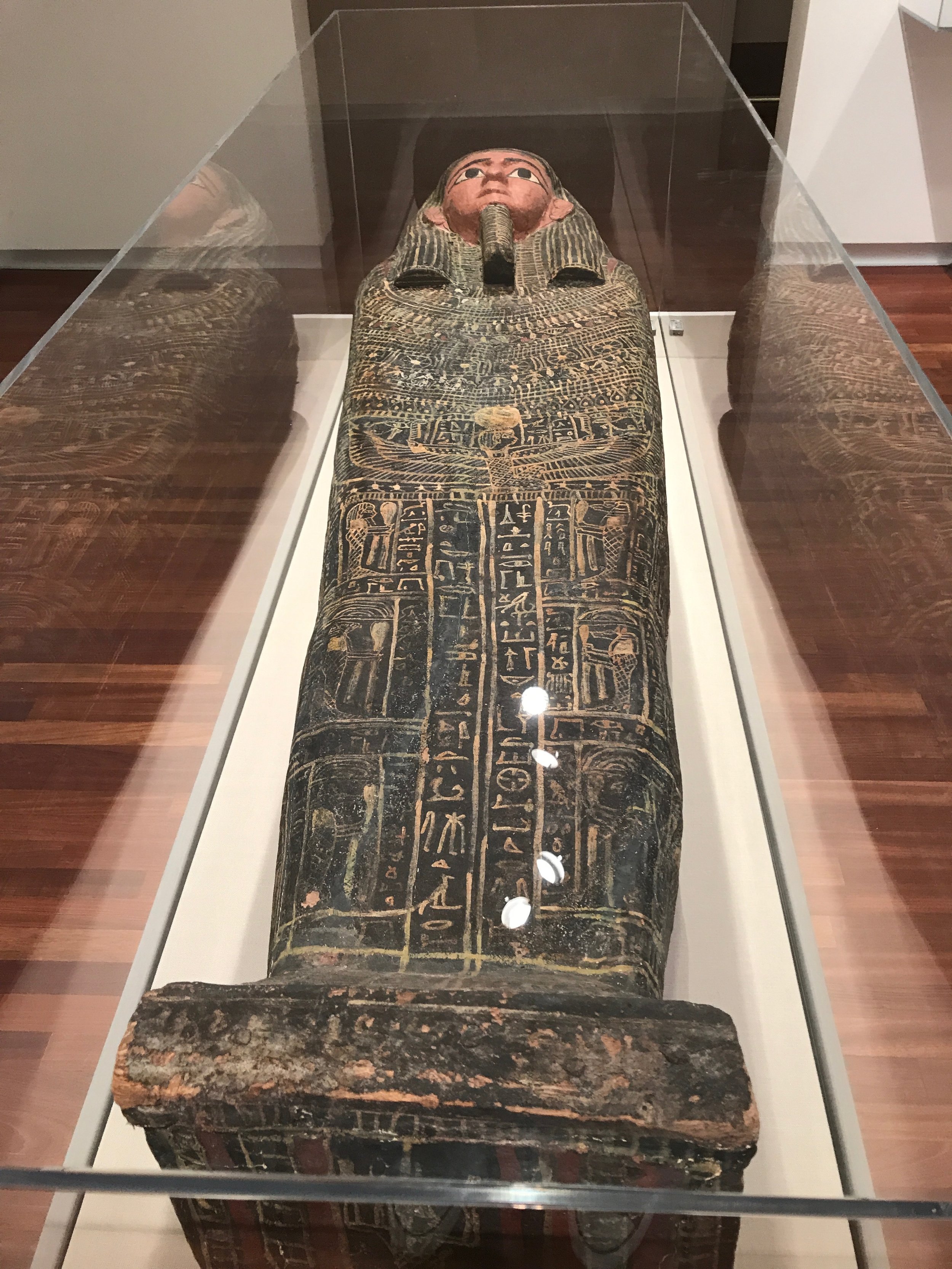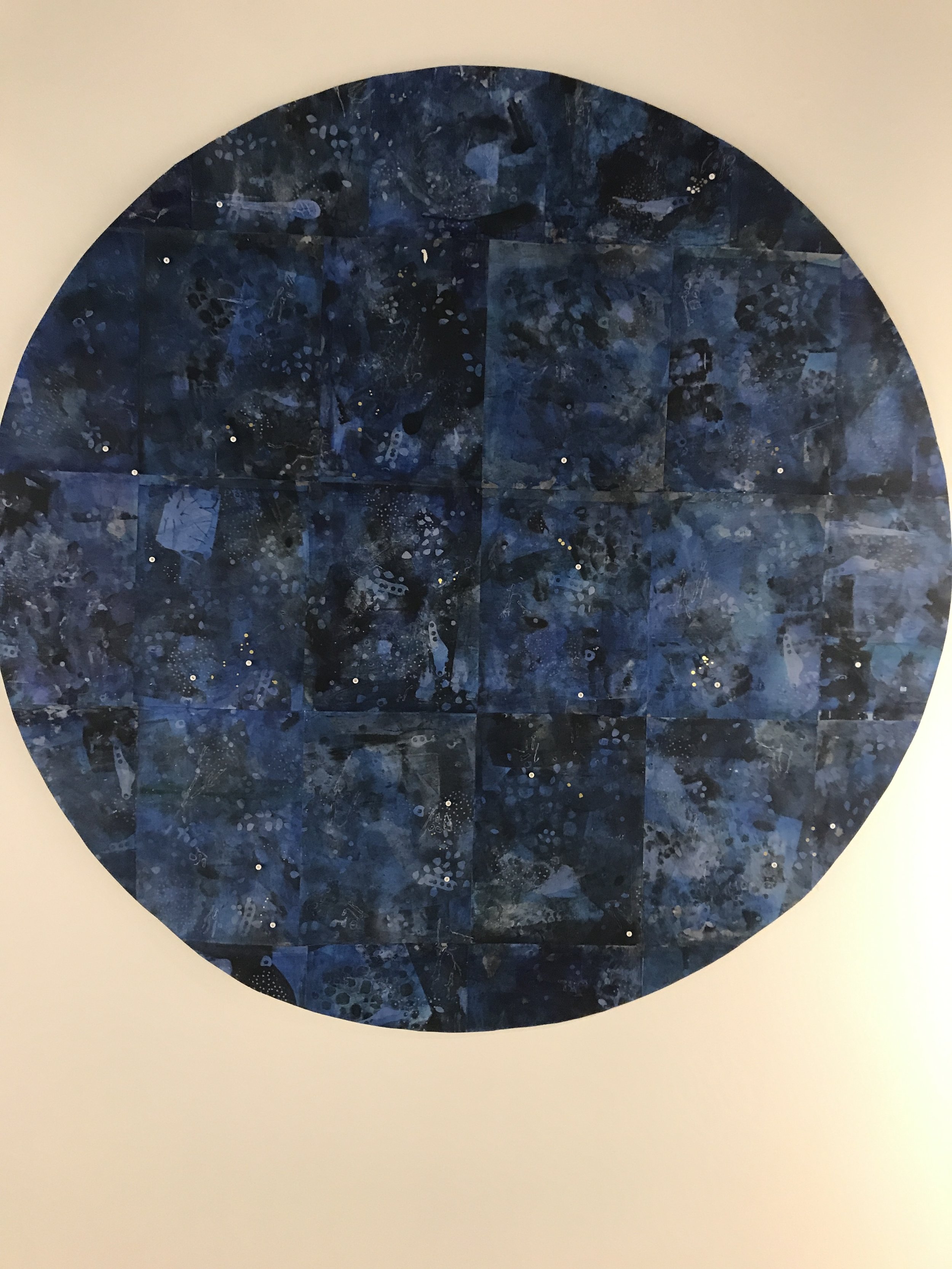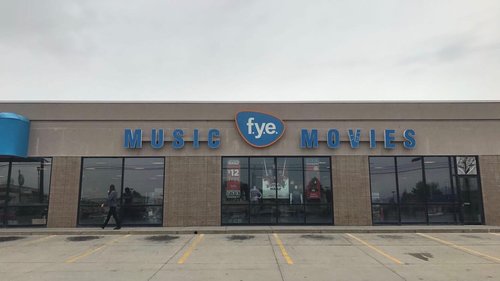UT Day 3 -Fine Art, Funky Art, and Oddly Familiar Sphinxes
Today started with me being less surprised to see a giant parrot in my Air BnB living room, and then moving on to get some coffee at Sugarhouse Coffee. The place was cozy, the coffee was strong, and the artwork was a very strange mix of sensual and horrifying. I loved it.
Today was a very artsy fartsy day, because it happened to be the free day at the Utah Museum of Fine Arts so I couldn't resist (though if you’re this far in my travels, I probably wouldn’t have put up much resistance anyways as art museums have certainly become a recurring theme). The first thing I saw as I entered the museum lobby was this massive and incredible oil painting entitled Canyonlands by Conrad Buff (a hell of a name). Buff was a Swiss painter who became particularly enamored with the landscapes of southern Utah, and I can see, because while the angle and perspective are nice artistic flourishes I can now say from experience that the landscapes down there really are as weird and wonderful as the one in this painting.
The first gallery was in a similar vein as the Buff painting, focusing on American art of the West with a special focus toward pieces either by Utahns (this is actually a correct term for someone from Utah) or regarding it’s landscapes. Pieces ranged from lush realism to hints of impressionism as the timeline of Western expansion approached the 20th century.
My favorite pieces here included: a beautifully vivid portrait of vagabond railriders (very relatable) entitled Private Car by Utah’s own Leconte Stewart; a more dreamlike impressionist drawing of a Bingham copper mine by Jonas Lie; and a stunning oil painting by Gilber Davis Munger of the Wasatch Mountains and the Great Salt Lake capturing a glorious early morning haze.
The next exhibit took place in the ACME Lab gallery for experimental art. The piece was entitled Our Futures and was organized by the arts collective Epicenter, whose works aspire to use arts and community outreach to revitalize their rural community of Green River, Utah. The current exhibition featured interactive multimedia displays to envision different visions for what Green River might look like in the year 2039. Pieces included posters for an imagined space camp, including audio recordings of fictional future Green River residents sharing their stories. The artwork for the fictional future business and was really fun, but the thing that stuck out to me the most was Epicenter’s vision for a sustainable future including lots of cool creations made from recycled materials including a fully functional clock made from an old computer hard drive and a motorcycle made from scrap metal. It was a fun and creative way of showing love for a home town, and it got visitors thinking of ways they can work toward making the best possible now through community outreach and sustainable practices which was commendable.
Up next, I moved to the upstairs galleries with a brief pitstop on the landing to take in this hulking ceramic sculpture by Viola Frey looking out over the museum and standing a staggering 12 feet tall.
The modern and contemporary wing was entirely dedicated to showcasing works by modern female artists and it was really a pretty exemplary collection with lots of big names feminist trailblazers from the 60s and 70s like Helen Frankenthaller and Yayoi Kusama as well as more contemporary artists. My favorite pieces were: an unusually malleable wire sculpture called Lace Skin Tear by Julianne Swartz; a hypnotic abstract painting that seems to shift and surge before your eyes called Infinity Nets by Yayoi Kusama; a deceptively simple stripped down portrait of Black femininity by Faith Ringgold called Soul Sister; a photo realistic painting of a bunch of laundry on the floor, the chaotic mess juxtaposed against the ordered geometric floorboards (a subtle dig at the idea of “women’s work”) by Sylvia Plimark Mangold; a haunting portrait of a young black woman surrounded by a dark abstract landscape called Periphery by Lynette Yiadom-Boakye; and a series of bonnets by Angela Ellsworth made from thousands of small corsage pins stitched together imbuing a symbol of gentle domesticity with a slightly unnerving sharpness to critique the more harmful aspects of that conception of gender roles. The breadth of styles and time periods on display really created a very lovely tribute to the sadly too often over-looked contributions of some truly incredible contemporary artists.
The big star of this wing was a special multi-part installation called salt 13, the 13th installment of the museum’s ongoing salt series that seeks to bring in both up and coming and prominent artists of the moment and give them a little extra room to experiment. The 13th installment showcased the works of Katie Paterson who created a series of pieces designed to explore ideas of space and people’s place in the universe while also stimulating all of the senses. The piece that immediately jumps out to visitors is a giant discoball sprinkling the room with constant rotation of shimmering light. Upon closer inspection though, the ball is no cheesy party supply store throwback to the 70s, but instead a hand made artifact comprised of 10,000 historic photographs of solar eclipses screen printed onto mirrors. The piece, entitled Totality, traces the history of man’s obsession with the heavens from early daguerrotypes to advanced telescopic photos, and yet simultaneously reverses the natural order of that obsession by creating thousands of points of light out of images of the sun literally being blocked out. I loved that it reached for lofty themes without losing a more light-hearted sense of fun and silliness. Within the room, almost eclipsed so to speak by the more dynamic centerpiece, was another series of pieces entitled Ideas that were poetic phrases of half thoughts and ideas cut into beautiful silver and mounted throughout the room barely visible until the light from the ball lit them up. My favorite idea sculpture (slightly visible in the bottom right corner) just cryptically said “precious metals/returned/ to their stars”. The last two more conceptual pieces were not actually currently on view because they were going to be part of a special event, but they sounded fascinating. The first one, entitled Candle, featured a specially layered candle designed by the artist to burn down over a twelve hour period releasing specially curated scents to create an olfactory journey from Earth to the Moon to the Sun to Mars to Jupiter to the Stars and into a Black Hole. I have no idea how that was supposed to work in practice, but I feel like art isn’t usually smell based so I don’t have much of a frame of reference. Lastly, a piece called Earth-Moon-Earth featured a pianist playing a score semi-composed by the moon itself. Paterson had Beethoven’s Moonlight Sonata translated into morse code and bounced off the moon via transmission. The signal that bounced back had a slightly altered composition as different waves were lost in space or refracted out of the correct trajectory after hitting a crater on the moon, and these lost segments became breaks in the morse code that led to a new score being translated back. It was such a funky idea, I was bummed I didn’t get to actually hear what it sounded like.
The next gallery I went to showcased art from Africa and Oceania featuring works both ancient and contemporary side by side. I found this gallery to be both surprisingly large and more detailed than similar exhibits I’ve seen in other museums in that they actually explained the cultural significance of every piece as opposed to just tossing them all together because they're from the same continent. I’ll be honest I was pleasantly surprised because in my own biases I really think of Utah being a very predominantly white state, so I didn’t expect such a focus on non-white art and culture, but beyond just the museum being a place that strives for inclusivity I realized that with the focus on missionary work in Mormon culture there’s probably actually more direct ties from Utahns to global communities than I would have expected. There were lots of different mediums on display, but the thing that caught my eye both aesthetically and as a window into different rituals were all the masks. In particular, I loved the Kuba masks (top left) from the Congo and the Asmat full body masks from Papua New Guinea. The Kuba masks are tied to initiation rituals with each highly ornate and geometrically patterned tied to a different royal or spirtiual figure. Young boys being initiated into being men in the tribe would learn these important histories and then be given the masks, and they would then wearing the masks go into town and scare women and small children before a big dance explaining. The Asmat masks really blew me away because the mask extended to cover the whole body. These masks were used to represent the spirits recently deceased and worn in ceremonies to celebrate their memories and ease their passage into the next world. It was both lovely but a touch playful, which is very much in line with my heavily Irish inspired family tradition for sending loved ones off. Not to mention the incredible handiwork!
The Asmat arts also provided two of my other favorite pieces in this collection two wooden sculptures that show man’s complex interdependent relation with nature. The one on the left shows a man stretching out his arms and becoming one with a bird, and the one on the right shows a canoe that also doubles as a metaphor for evolutions as more animalistic figures rowing in the back gradually become more humanoid as they get to the front of the boat.
The next galley was a temporary exhibit showcasing the stunning silver gelatin prints of Marilyn Bridges. Her unique works of monumental landscape photography taken from airplanes serve as weird and beautiful bridge between the disparate worlds of documentary and abstract art, at once capturing true portraits of places from around the world but from a distance where they hardly resemble more than geometric patterns.
These two in particular knocked my socks off because I don’t think if you were told they were photographs you would ever guess they were. They are a cornfield in Oklahoma and a mountain range in Peru respectively.
I took a bit of a step backwards in time for the next gallery which featured mostly ancient arts from Asia (in this particular collection mostly highlighting works India and China). There were some really ornate stone sculptures from Hindu temples, beautiful and surprisingly modernist-seeming paintings from as early as the 1600s, and more incredible Chinese porcelain that still have a pretty glorious luster hundreds of years later. My favorite of the latter was a large imperial vase with an almost MC Escher-esque pattern of alternating bats and clouds.
An interesting bridge between the Asian Art and the European wing was a small gallery of late 19th/early 20th century art when both Japanese woodblocks and impressionism were taking the world by storm. It’s easy to think of different global movements as being totally isolated because when you learn about them in history classes they tend to be discrete lessons, but life rarely happens in anything resembling neat or distinct chunks. This gallery beautifully showed the mutual influences of the two transcontinental styles on each other from French painters trying to emulate the lyrical approach to representing nature in Japanese art (left) or Japanese painters adopting impressionist styles such as pointillism to approach traditional subject matter from a whole new angle (right) and it really twisted my brain in a sort of magical way.
Next up came a pretty comprehensive survey of European art featuring a smattering of Dutch masters, a touch of French Impressionism, a dab of Renaissance religious outings, and even a sprinkling of ornate medieval tapestries. This may sound like a touch of art fatigue from the many European wings I’ve visited in my days at this point, but honestly each piece is still pretty unique and just when I think I’ve seen all there is to see of a certain style I’m pleasantly surprised by delightful oddities like Pieter Brueghel the younger’s raucous painting of a maypole dance or a 19th century painting of fisher folk that seems to contain a novel’s worth of emotion by Philip Lodewijk Jacob Frederik Sadee who has a novel’s worth of a name.
My absolute favorite from this wing though was called Retour de Marcus Sextus dans sa Famille by Pierre Narcisse Guerin, showing the imagined historical character of Marcus Sextus sitting at his wife’s deathbed with maybe the best representation of the face you make for the thought “What the hell do I do now?” I’ve ever seen.
Next up were some pieces from antiquity largely featuring European and Egyptian approaches to burial, featuring mummies large and sadly small, a Greek tomb, ceremonial jewelry and one Grecian urn because you are contractually required to have at least one of those if you call yourself a fine arts museum.
Lastly was a small but really cool gallery of Mesoamerican art featuring detailed clay ceramics of fertility figures and also interestingly lots of bats as well as some absolutely stunning jewelery made from basically pure gold.
It was a great exhibit, but this cabinet of babies is pure nightmare fuel:
Up next I went to the highly recommended Gilgal Gardens, a small public park filled with blooming flowers and, more notably, 12 gigantic stone sculptures by master stonemason Thomas Child. Beside being a mason, Child was a devout Mormon and he wanted to create the garden as a way of expressing the ideas about faith and life that he acquired in the 57 years of life he had lived before undertaking this monumental project. Some of the works are more overtly religious than others, but every sculpture has such massive scale and bizarre modernist flourishes that were it not for the occasional Bible or Book of Mormon verse carved into the stones you’d think the garden was much more in line with abstract and modern art movements than any sort of traditional religious artwork. All the quirkiness really gives the place a much deeper sense of welcoming charm, which I think speaks to the character of the man who created it as Child once said of the place “You don’t have to agree with me. You may think I am a nut, but I hope I have aroused your thinking and curiosity.” I love that Child gave the the space a built in self-awareness of its own strangeness, and the potentially off-putting nature of some of the proselytizing, because it sort of reframes everything as a purer expression of one man’s joys and passions that happened to sometimes derive from religion as opposed to a place where you were trying to be converted. It also helps that he was truly an incredible artist to back up some of the oddball choices being able to really deftly alternate between highly realistic, more dreamlike, and totally abstract styles of representation in stonework. On top of all that, the sculptures are significant because he was one of the first artists to use a welding torch to approach carving rock the same way people tend to sculpt with metals. The heat from the torch not only made it an effective carving tool, but also created interesting reactions with stone creating beautiful and unusual colors and giving the pieces an otherworldly sheen and shine. Between the genuine skill and runaway imagination, you can see why the garden has become a popular hidden gem tucked in the suburbs of SLC.
My two favorite pieces hitting that perfect storm of impressive scale, crazy detailing, and gonzo weirdness were: a sculpture of the captain of God’s angels who came to Joshua in the battle of Jericho where Child gives the body a very classical Greek soldier quality but goes totally modernist with the head leaving a large un-sculpted chunk of stone because he felt the abstraction creates a greater sense of awe at the unknowability of the face of the divine; and naturally the garden’s centerpiece a massive Sphinx with the uncannily carved face of Joseph Smith instead of the slightly more traditional Egyptian one. It’s so wrong and so right at all the same time, in it’s beautifully unironic embrace of the absurd.
For lunch, I decided to get a little Mexican food albeit pretty north of the border at a place called the Red Iguana which had really positive TripAdvisor recommendations. I unintentionally came on the perfect day too because it Taquito Wednesday (a less alliterative cousin to Taco Tuesday) so there was a sweet deal on special mini tacos. I got one with carnitas, one with cochinta pibil (a pork loin rubbed with spices and lime and slow roasted to perfection), and one with sautéed mushrooms, and it all came with tasty homemade chips and salsa, beans, cheese, and guacamole. It was a real feast, and I enjoyed each taco greatly with the cochinta pibil getting a slight edge as the favorite because of all that excellent seasoning but I could just as easily have enjoyed three of any of my choices. The black beans too deserve a special shout out. I don’t know what they did differently than most other places, but they were pretty darn great.
After lunch, I continued my artsy fartsy day with a trip to the Utah Museum of Contemporary Art. It was a teensy bit smaller than the Museum of Fine Arts, but it had a really exceptional collection of funky exhibits that actually made them one of the best contemporary art museums I’d visited so far.
The first exhibit was entitled The Forge, The Gibbous, The Heron, The Oilcan by Wren Ross, and it featured these beautiful surreal water colors that served as star maps for constellation of an imagined mythological cultures. The pieces combined lyrical scrawling with the dreamy images to try to emulate in picture form the idea of oral storytelling, the medium in which myths have most historically been past down. It was deeply layered, weird and lovely.
Next up was a stylish mix of installation and video art entitled Home Bodies, Away Teams by Earl Gravy, an art collective primarily made up of Emma Kemp and Daniel Wroe but also featuring a rotating lineup of collaborators from the LA art world. The project took inspiration from the primary artists’ research into a bizarre spiritual commune that developed in Southern Utah in the early 1930s. Marie Margaret Ogden was a homesteader who in 1933 brought about a 100 devoted followers to southern Utah and housed them in cabins where they followed her spiritual teachings and tried to find a cure for death. It’s a bizarre little historical footnote that caught the artists’ imaginations, and their installation seeks to share and connect with this story by featuring videos both documenting their research and visitation to the site of the former commune as well as just more thematically linked video art. A big part of the piece though is a constant disruption of the viewer’s expectations, as the room is littered with seemingly mundane objects that don’t behave quite like their supposed to. Ladders bend at impossible angles, floorboards ramp up off the floor, velvet table cloth goes in and over as well as under the sculptures on the table, and TVs pop up all over the place. A cool interactive highlight is a little unassuming white alter with holes on the bottom of it. The viewer is encouraged to genuflect and kneel on some cushions by the alter and put their heads in the hole. In the whole is a dark tunnel leading to a mirror, so in a pose of spiritual seeking the viewer sees only themself reflected back. I’m not sure if it’s a lovely metaphor for the spiritual power within or a bit of a dig at the emptiness of religious promises but it was certainly a unique and trippy experience and I like that you can read into however you’d like.
Also, this might not surprise you given the pictures and descriptions above, but some of the non-documentary films in the installation were super super weird. Case in point, this vaguely angelic image you’ll never be able to unsee:
The largest exhibit was entitled Desire Lines, and it brought together several artists and sought to take a very traditional form of art, the landscape painting, and showcase novel, unusual, or technologically innovative modern variations on the same theme. I love this kind of exhibition, because it’s cool to see how so many different artists can be given the same basic starting point and still go into all kinds of different directions. There were sculptures, paintings, photographs, and pieces that refused to fit neatly into traditional media categories. Some really inventive pieces that probably require some explanation of the unique artistic approaches included: a landscape photo that was uploaded to a computer and intentionally exposed to a virus that caused different pixels to glitch and alter creating a new fantastical landscape (top right); a seemingly abstract piece that is actually cotton exposed to toxic water so the dirt and grime would rush over it and get somewhat absorbed by the cotton making unusual marks that are both a “painting” by the landscape and a salient reminder of environmental pollution (middle left); a bunch of classic landscape photos from old atlases and magazines that the artist then filtered through hundreds of different phone apps making them almost unrecognizable and new again like a millennial take on Andy Warhol’s pop-art screen prints (middle center); and a light box that combined wood carving on the frame, photography, and electronic lighting (bottom right). Other pieces that used more traditional media such as wood carving and painting still exuded enough skill and bold choices to still really fresh.
My personal favorites here included: an unusual sculpture/phot hyrid entitled Rock Moss Cliff by Kristen Kay Thoen that featured a photograph of mossy rocks printed onto a special canvas and then draped over a rock shaped sculpture to give the sense that photo was also trying to regain its original form; an incredibly detailed drawing by Molly Kaderka of a really tightly zoomed in piece of dirt entitled Badlands that finds hypnotic, zen-like beauty in the most mundane of settings that would otherwise be so easy to overlook with painstakingly precise linework; a series of gouache paintings by Sarah Frantz called To Await from the Stars that featured views of the sky surrounded by abstractions of some of the most captivating color and consistency combinations; and a piece called Between Here and There by Amelia Carley that completely deconstructed the idea of a landscape painting into three distinct components the sun via a projected filtered bar of light, sky via a slightly more traditional oil painting, and mountains via a foam sculpture covered in sand making for a disjointed but oddly satisfying whole.
Lastly was possibly my favorite piece of video art I’ve ever seen, a project called, fittingly and ironically, Landscape Painting by Julius von Bismarck. In the piece the artist and small crews of local workers go into remote sections of the Mexican desert and the Mayan Jungle and very literally paint the landscape. At first they paint the entire landscape a stark white, and then they go back and try to paint it back to all the original colors, the whole tedious, intensive, redundant process caught on tape. As a performance piece, I’m sure there are lots of mildly pretentious themes about the futility of man trying to conquer nature and all that, but as a video it transforms into a really funny and beautiful piece of absurdity. It almost gives the impression that these painters are contractors of a divine bureaucracy who are finishing up a slightly unfinished piece of creation. The deathly serious concentration on their faces juxtaposed with the utterly pointless task they were completing was to me art of the highest order.
After all that art (contemporary, fine, and vaguely mormon alike), I was pretty worn out and in need of some more coffee. I went to a place within walking distance of the night’s open mic called La Barba, which was a classy little establishment that bottled their own cold brew to go. I got some of that and greatly enjoyed it, though I did realize perhaps a bit late that I should have been a bit more careful of drinking something that looks so much like a beer out on the streets of SLC while I was walking to the mic.
The mic was at a really great comedy club in downtown Salt Lake called Wiseguys. It was clearly a pretty big deal in the local scene, because when I was walking by at 4pm there was already a line forming outside for the 6pm sign up. The mic itself didn’t start until 7, which I think illustrate the little bit of madness that is required to want to seriously pursue comedy because people are willing to wait for three hours to talk for 3 minutes. I myself can’t judge, because when I saw that line I happily joined them without a moment’s hesitation. The wait wasn’t so bad though, because I ended up getting to chat with some of the comics I had met earlier, namely two really nice guys named Adam Conrad and Primo. I also met a few new comics (new to me not new to comedy) who were incredibly welcoming, and they all had me laughing big belly laughs before the mic even started. I even met one guy named Brian Higgins who had recently moved here from Connecticut so we ended up bonding, talking about that scene and trying to remember if we had overlapped any almost half a year ago when I was there.
Once the mic got started, I understood why everyone was so willing to wait. There was a great stage and sound system, and best of all a real audience who was there to have a good time. That’s the advantage of having an open mic in a real comedy club, and it helps when it’s pretty well established like Wiseguys. The actual comedy was a bit all over the place which is perhaps the double edged sword of a great venue. The real comics brought their A games, but it also actually shows up on the radar of crazy people and first timers who might not otherwise know about smaller mics. For first timers, it’s okay to be a bit rough around the edges, but as is the case everywhere not just SLC a lot of first timers mistake shocking for funny. One bad rape joke can ruin the vibe of a room, but it is a testament to the positivity of the crowd that they were still supportive after sitting through several. I don’t mean to sound too critical, because like I said this is also a chance for up and coming comics to get better than average exposure so there was also a ton to love as these comics did their absolute tightest three minutes.
Some highlights for me:
Tanner: Do you ever get other black people making fun of you for your white mom and white name?
Mac Garnder- The most super thing about super man is that he was raised by two farmers in Kansas and he never says the n word
Adam Conrad - Benjamin Button would have been a waaaaayyyy different movie if in the beginning he looked five. Like “oooh this is dark”
Brian Higgins- I’m trying to convince my google search that I’m the fastest man alive.
Alex Coy - Religion is weird. Like you wanna believe in a God that made chocolate kill dogs?
Greg Orme - (I don’t know know how to explain this one without his fantastic delivery, but I was absolutely destroyed by Greg’s story about witnessing a guy excusing himself from dinner and just saying “there’s too much BBQ sauce”)
My personal favorite comic of the night was Carl, who had also impressed me two mics ago with a flawless Christopher Walken impression. I got the feeling he was a little nervous telling this story because it involved being very open about his trans-ness, but it was such a funny story that I hope he keeps doing it. Basically it can be summed up in the perfect dead pan, “Have you guys ever got so drunk at a bar you left your dick in the bathroom?”
My unintentional favorite of the night was an incredibly drunk man who got up and said the absolutely insane phrase “I’ve got six daughters, so you know I’m going to heaven”. It’s been months now and I still have no clue what he was going for, but boy did he go for it, rambling well past the three minute mark and mistaking the nervous laughs of confusion as positive encouragment so much so that he ended his set by throwing up two peace signs and bellowing “See you fuckers in Hollywood!” It was an almost virtuosic performance of self-delusion.
My own sent went surprisingly well. I say surprising partly because I went up pretty close to the end, and also something about covering the elevation change from Phoenix to Salt Lake in such a short amount of time really did a number on my sinuses and I started coming down with a pretty heavy cold (I’m sure waiting outside for two hours probably helped). My eyes were so watery I literally couldn’t see the audience and my head was totally numb (the couple beers probably didn’t help, but the Wasatch Devestator Double Bock was a delightful discovery) but I somehow faked my way through some well-worn jokes and managed to make a pretty good impression even if I don’t necessarily know how.
After the mic, I decided to get one last coffee to try to jumpstart the old immune system and hopefully be able to do a little writing for the night. I went to an awesome little comic book shop/board game shop/cafe called the Watchtower Cafe. It was really hitting a lot of buttons for me, and I ended up getting sucked into a fun conversation about comic books with the barista that really made me miss how much I haven’t been able to keep up with my favorite series on the road. The coffee was very tasty on top of the great atmosphere, but unfortunately very little would have been strong enough to overcome my developing head cold, so I quickly succumbed and passed out shortly after arriving at the air bnb. There are certainly worse ways to end an artsy fartsy day.
Favorite Random Sightings: Bad Apple iPhone Repair; Palace Meat (short and sweet today)
Regional Observations: I can’t say this with any certainty but I believe in SLC I may have stumbled into the last remaining FYE not in a mall of some sort. Gaze upon it ye mighty and despair
Albums Listened To: Sigh No More by Mumford & Sons (pleasantly surprised by some songs, but as a whole album it’s a bit of a slog); Sing Loud, Sing Proud by Dropkick Murphy’s (straight up goofy, but it was a fun reminder of home); Single (Bombs Over Baghdad (rock remix)) by Outkast w/ Rage Against the Machine
People’s Favorite Jokes: Why don’t monkeys have pocket watches? because they don’t wear pants
Songs of the Day:
I like this stripped down version of the song, but honestly I’m mainly sharing this particular clip for wondeful this bookstore looks
this is a lot
i love how ridiculous the colors are, they can really rap over anything.




